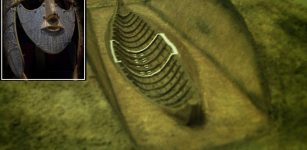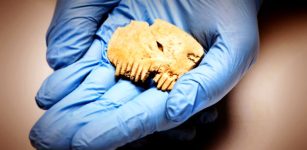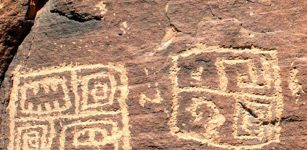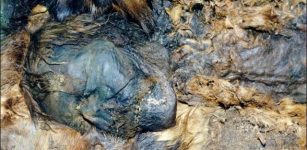Why Was The Magical Sword Azoth Of Paracelsus So Special?
Ellen Lloyd – AncientPages.com - Magical swords are frequently mentioned in myths and legends, but did you know Paracelsus had a very unusual sword that had a life of its own?
Azoth, the magical sword of Paracelsus, was special in many ways.
Left: Paracelsus. Credit: Public Domain - Right: A Magical sword. Credit: Stock Photo
Paracelsus was described as an arrogant fool due to his lack of social skills, but he was no such thing. He was a fascinating person with a complex personality and a scientist who was much ahead of his time. Most people, even today, would find the self-confident Paracelsus to be very eccentric, but his background, studies, work, and goal to the truth made him the man he was.
Paracelsus (1493 - 1541) was a Swiss-German botanist, philosopher, astrologer, alchemist, and one of the most influential medical scientists in early modern Europe. As a young boy, he became interested in alchemy, and in time it became a passion that stayed with him all his life.
Paracelsus became a very controversial figure who, like many other Renaissance scientists, became a bridge between the new and old world in his short lifetime.
The Renaissance period that spanned the 14th century to the 17th century changed Europe in many ways, and Paracelsus was one of many unusual and talented scientists who contributed to these changes.
Renaissance scientists like Paracelsus opened doors to a new world. Credit: Renaissance Portal, painting by Robert Breyer, (1866 - 1941)
It may sound like a contradiction, but Paracelsus, who was deeply fascinated with mysticism, alchemy, astrology, and magic, was also very religious. His interest in the occult led him to be accused of being a devil worshipper, but this was not true. Paracelsus simply believed the mystery of nature was the mystery of God.
During Medieval times, alchemists were often persecuted. Therefore, they had to invent their own complex vocabulary of alchemy signs and symbols to conceal their ingredients, memorize their knowledge, and keep it secret. Like most of all alchemists, Paracelsus had three goals, to find the Stone of Knowledge (The Philosophers' Stone), to discover the medium of Eternal Youth and Health, and to discover the transmutation of metals.
The four elements of Alchemy are salt, mercury, sulfur, and azoth.
Being a man who avoided social contact, it’s difficult to determine what is true and not about his many inventions. Paracelsus kept to himself and experimented much with chemicals. What he really accomplished, no one can tell with certainty. However, some people spread rumors Paracelsus owned a strange sword that he slept with by his side. The sword named Azoth was one of the reasons Paracelsus became suspected of sinister behavior and contact with dark and evil forces. Azoth was said to be three to four feet long with a cross guard and globular pommel.
The 1567 "Rosicrucian" portrait. The word Azoth is inscribed on the sword Paracelsus is holding. Credit: Public Domain
It could have been just an ordinary sword, but it was not. People said the sword was alive! It could dance and frequently made a continuous rattling sound waking up Paracelsus’s neighbors.
Why Paracelsus needed a sword such as Azoth has never been explained, but being a bad-tempered, controversial scientist made him many enemies. Some think he kept the sword close to protect himself from danger.
To laymen, Paracelsus’s sword Azoth may have been a curious and dangerous weapon capable of performing magic. One story tells that inside the sword handle, the great alchemist Paracelsus “kept his familiar, who would be released from Azoth to produce things for his master, such as gold coins, to pay for a night’s sleep at an inn.” 1
In alchemy, Azoth “is considered the Universal Medicine, to which all things are related, containing within itself all other medicines. It is also the term for the Mercury of any Metallic Body. Azoth is considered as a living spirit.” 2
Perhaps this was the reason people spread rumors his sword, Azoth, was alive.
No such sword has ever been found, and its existence remains in the realm of mythology, though there are portraits of Paracelsus holding a sword that bears the inscription Azoth.
If you enjoyed this article consider becoming a member. Our member section offers a wealth of informative and insightful articles similar to this one. Upgrading to a premium membership gives you access to all our articles, including our library of ancient and unexplained mysteries.
Updated on August 4, 2024
Written by Ellen Lloyd - AncientPages.com
Copyright © AncientPages.com All rights reserved. This material may not be published, broadcast, rewritten or redistributed in whole or part without the express written permission of AncientPages.com
Expand for references- All About History - History Of The Occult, 2018, Future Publishing Limited
- Israel Regardie, Chic Cicero, Sandra Tabatha Cicero - The Philosopher's Stone: Spiritual Alchemy, Psychology, and Ritual Magic
More From Ancient Pages
-
 Mystery Of The Knights Templar – Did A Secret Ancient Meeting Determine The Real Purpose Of The Christian Knights? Part 1
Ancient Mysteries | Aug 20, 2019
Mystery Of The Knights Templar – Did A Secret Ancient Meeting Determine The Real Purpose Of The Christian Knights? Part 1
Ancient Mysteries | Aug 20, 2019 -
 Sutton Hoo Ship Burial And Famous Helmet That Could Belong To Raedwald, King Of All The Kings Of Britain
Artifacts | Jan 9, 2018
Sutton Hoo Ship Burial And Famous Helmet That Could Belong To Raedwald, King Of All The Kings Of Britain
Artifacts | Jan 9, 2018 -
 Pottery Found On Jiigurru/Lizard Island Rewrites Aboriginal History
Archaeology | Apr 12, 2024
Pottery Found On Jiigurru/Lizard Island Rewrites Aboriginal History
Archaeology | Apr 12, 2024 -
 On This Day In History: Eugène Dubois Who Discovered Remains Of Java Man Was Born – On Jan 28, 1858
News | Jan 28, 2017
On This Day In History: Eugène Dubois Who Discovered Remains Of Java Man Was Born – On Jan 28, 1858
News | Jan 28, 2017 -
 Mystery Of The Bar Hill Comb Solved
Archaeology | Mar 13, 2023
Mystery Of The Bar Hill Comb Solved
Archaeology | Mar 13, 2023 -
 1,500-Year-Old ‘Magical Mirror’ To Protect Against Evil Eye Discovered By A Teenager In Israel
Archaeology | Aug 9, 2023
1,500-Year-Old ‘Magical Mirror’ To Protect Against Evil Eye Discovered By A Teenager In Israel
Archaeology | Aug 9, 2023 -
 Merovingian Dynasty Of Long Haired Kings
Featured Stories | Jan 18, 2019
Merovingian Dynasty Of Long Haired Kings
Featured Stories | Jan 18, 2019 -
 Does A Baffling Artifact Offer Evidence Of Ancient Extraterrestrial Visitation In New Zealand? – Experts Investigate – Part 2
Ancient Mysteries | Jul 23, 2020
Does A Baffling Artifact Offer Evidence Of Ancient Extraterrestrial Visitation In New Zealand? – Experts Investigate – Part 2
Ancient Mysteries | Jul 23, 2020 -
 Neanderthals Weaned And Raised Their Children Similarly To Modern Humans
Archaeology | Nov 3, 2020
Neanderthals Weaned And Raised Their Children Similarly To Modern Humans
Archaeology | Nov 3, 2020 -
 Dead City Of Serjilla – Byzantine Village In Syria Struggling To Survive The Middle Of A War Zone
Featured Stories | Jan 27, 2020
Dead City Of Serjilla – Byzantine Village In Syria Struggling To Survive The Middle Of A War Zone
Featured Stories | Jan 27, 2020 -
 Where Is One Of Colorado’s Most Mysterious Long-Lost Artifacts? Have New Clues Emerged?
Featured Stories | Aug 20, 2024
Where Is One Of Colorado’s Most Mysterious Long-Lost Artifacts? Have New Clues Emerged?
Featured Stories | Aug 20, 2024 -
 Controversial Evidence – Ancient Chinese Visited America 2,500 Years Ago
Civilizations | May 9, 2015
Controversial Evidence – Ancient Chinese Visited America 2,500 Years Ago
Civilizations | May 9, 2015 -
 Ancient Race Of Star Worshippers And Secret Message Stored In Unusual Monument
Ancient Mysteries | Jun 11, 2018
Ancient Race Of Star Worshippers And Secret Message Stored In Unusual Monument
Ancient Mysteries | Jun 11, 2018 -
 Discovered Near Arctic: Mysterious Lost Medieval Civilization And Puzzling Ancient Mummy
Archaeology | Jul 4, 2015
Discovered Near Arctic: Mysterious Lost Medieval Civilization And Puzzling Ancient Mummy
Archaeology | Jul 4, 2015 -
 Ensisheim Meteorite Is The Oldest Meteorite With A Precise Date Of Impact
Ancient History Facts | Jun 29, 2018
Ensisheim Meteorite Is The Oldest Meteorite With A Precise Date Of Impact
Ancient History Facts | Jun 29, 2018 -
 Mummification In Europe May Be Older Than Previously Known – 8,000-Year-Old Evidence Presented
Archaeology | Mar 4, 2022
Mummification In Europe May Be Older Than Previously Known – 8,000-Year-Old Evidence Presented
Archaeology | Mar 4, 2022 -
 Who Was The Sapa Inca?
Featured Stories | Jul 29, 2024
Who Was The Sapa Inca?
Featured Stories | Jul 29, 2024 -
 Mahabalipuram: Ancient Ruined City And Its Marvellous Rock-Cut Architecture In South India
Featured Stories | Jul 25, 2021
Mahabalipuram: Ancient Ruined City And Its Marvellous Rock-Cut Architecture In South India
Featured Stories | Jul 25, 2021 -
 Major Underwater Archaeological Find On The Western Coast Of Sicily – Artifacts From The Battle Of The Egadi Islands?
Archaeology | Sep 11, 2023
Major Underwater Archaeological Find On The Western Coast Of Sicily – Artifacts From The Battle Of The Egadi Islands?
Archaeology | Sep 11, 2023 -
 Unexplained Visions Of Airmen – Strange Presence And Disturbances – Part 1
Featured Stories | Feb 6, 2020
Unexplained Visions Of Airmen – Strange Presence And Disturbances – Part 1
Featured Stories | Feb 6, 2020



